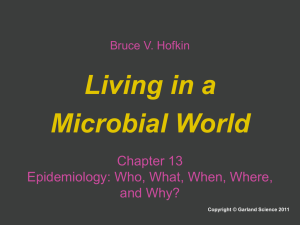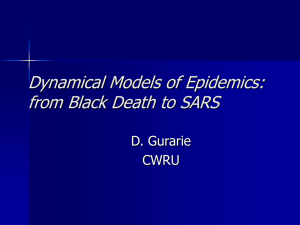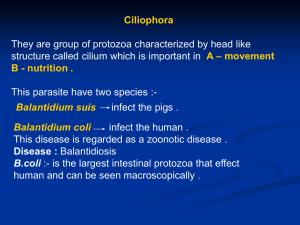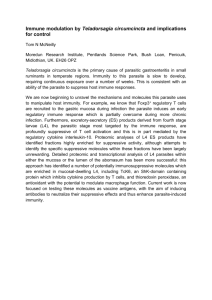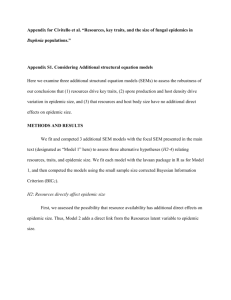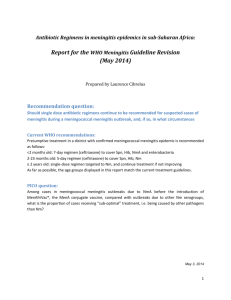L8-epidemiology
advertisement
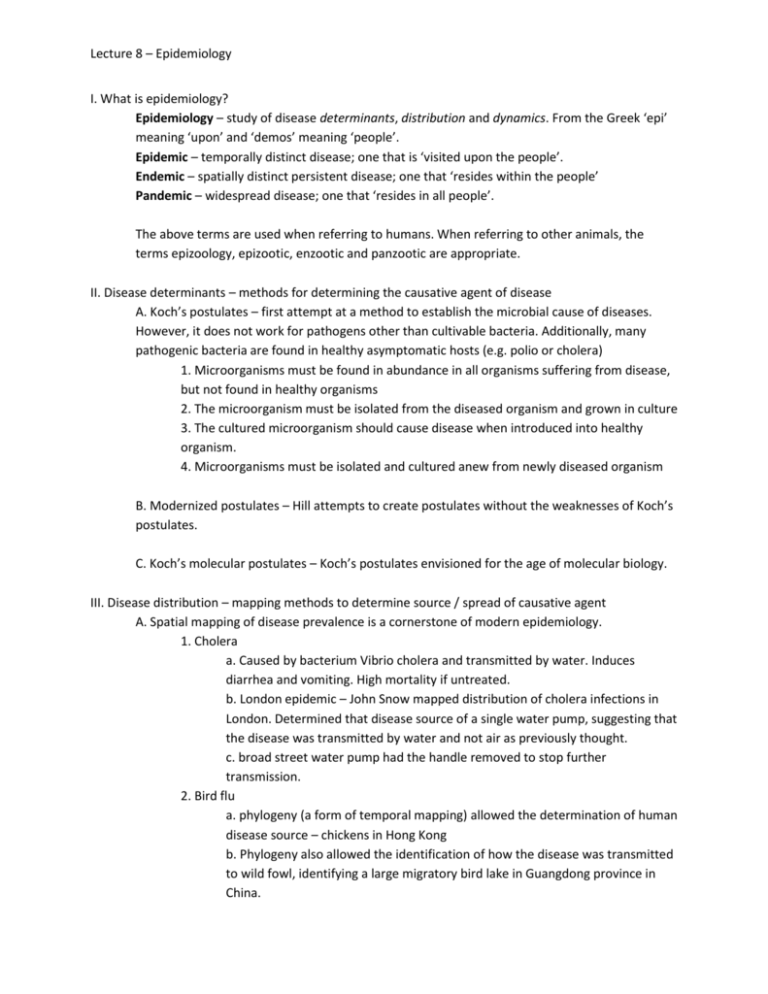
Lecture 8 – Epidemiology I. What is epidemiology? Epidemiology – study of disease determinants, distribution and dynamics. From the Greek ‘epi’ meaning ‘upon’ and ‘demos’ meaning ‘people’. Epidemic – temporally distinct disease; one that is ‘visited upon the people’. Endemic – spatially distinct persistent disease; one that ‘resides within the people’ Pandemic – widespread disease; one that ‘resides in all people’. The above terms are used when referring to humans. When referring to other animals, the terms epizoology, epizootic, enzootic and panzootic are appropriate. II. Disease determinants – methods for determining the causative agent of disease A. Koch’s postulates – first attempt at a method to establish the microbial cause of diseases. However, it does not work for pathogens other than cultivable bacteria. Additionally, many pathogenic bacteria are found in healthy asymptomatic hosts (e.g. polio or cholera) 1. Microorganisms must be found in abundance in all organisms suffering from disease, but not found in healthy organisms 2. The microorganism must be isolated from the diseased organism and grown in culture 3. The cultured microorganism should cause disease when introduced into healthy organism. 4. Microorganisms must be isolated and cultured anew from newly diseased organism B. Modernized postulates – Hill attempts to create postulates without the weaknesses of Koch’s postulates. C. Koch’s molecular postulates – Koch’s postulates envisioned for the age of molecular biology. III. Disease distribution – mapping methods to determine source / spread of causative agent A. Spatial mapping of disease prevalence is a cornerstone of modern epidemiology. 1. Cholera a. Caused by bacterium Vibrio cholera and transmitted by water. Induces diarrhea and vomiting. High mortality if untreated. b. London epidemic – John Snow mapped distribution of cholera infections in London. Determined that disease source of a single water pump, suggesting that the disease was transmitted by water and not air as previously thought. c. broad street water pump had the handle removed to stop further transmission. 2. Bird flu a. phylogeny (a form of temporal mapping) allowed the determination of human disease source – chickens in Hong Kong b. Phylogeny also allowed the identification of how the disease was transmitted to wild fowl, identifying a large migratory bird lake in Guangdong province in China. Lecture 8 – Epidemiology c. By linking modern phylogenetic technique with spatial mapping, bird flu spread to the rest of the world was minimized. IV. Dynamics A. Modern epidemiology seeks to understand how epidemics unfold and how diseases are maintained endemically within populations. B. Early attempts at understanding how epidemics unfold 1. Small pox epidemic – small pox cuased by Variola major and Variola minor viruses and is transmitted via the air. Mortality rate of V. major is 35%. Immunity can be induced via variolation, which involves inhaling dried scabs from infected patients. Latter, vaccine developed from a related disease, cow pox. This was the first vaccine ever developed and small pox is the first disease ever to be eradicated via vaccination. 2. Daniel Bernoulli was a Swiss mathematician and physicist who performed one of the first epidemiological analyses of disease dynamics. Using the small pox epidemic of London, he created three groups of individuals; those that were susceptible to the disease, those that were infected and those that had recovered and were immune. He found that by simply vaccinating a small proportion of the population would provide a large benefit to the susceptible population. C. Modern attempts to understand epidemics involves epidemiologic modelling 1. SIR models – compartmental models that allow the progression of epidemics in large populations to be modelled. The most common of which is the SIR (Susceptible Infected Recovered). See PowerPoint for equations. a. General SIR models assume density dependence in disease transmission and infection via mass action. Mass action states that all individuals meet within a population meet at random and in proportion to their numbers. b. SIR models predict that diseases can be maintained endemically with high birth rates (or immigration rates). Otherwise, diseases are prone to fadeout (i.e. extinction of parasite post epidemic). c. SIR models predict that short lasting immunity of recovered population can help sustain an epidemic. d. SIR models predict high virulence can lead to fadeout. 2. Conditions by which parasites can persist in a population can be predicted by I(hat). a. increased background host mortality allows the parasite to persist in high numbers. Lecture 8 – Epidemiology 3. Minimum population size of susceptibles need for parasite to establish is provided by Scrit. 4. Minimum number of vaccinated susceptibles needed to eradicate a parasite is given by Pcrit. D. Parasite persistence – ways in which a parasite can persist if it runs out of susceptible hosts. 1. Carrier state – continued presence of organism in host that causes no symptoms. Example – Typhoid Mary. 2. Parasite latency – parasite lays dormant in host for extended period of time, resulting in cyclic outbreaks or epidemics. 3. Biological reservoirs – parasite is endemic in one species, but causes periodic epidemics in another species. Examples are rabies in jackals and Ebola in humans. 4. Extensive incubation periods – beneficial when host mortality rates are low or when alternative biological reservoirs are absent. Example – Transmissible spongiform encephalopathies. 5. Environmental reservoir – some pathogens can exist outside of a host for extended periods of time. Examples – endospores. 6. Metapopulation structure – subdivided host population can allow parasites to cycle between populations. Subdivisions may arise socially, spatially or temporally. E. Extensions of SIR models – SIR models are often unrealistic. However, they can be modified to accommodate a variety of circumstances. 1. Type of parasite (e.g. macroparasite versus microparasite). 2. Population structure 3. Latency period 4. Immunizations 5. Transmission mode 6. Network connectivity 7. Spatial heterogeneity 8. host heterogeneity 9. within host dynamics.

